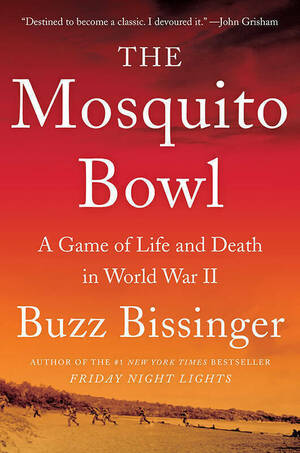Buzz Bissinger is famous for having written Friday Night Lights, that ode to high school games in football-mad Texas. So when my men’s book club in Camden, Maine, decided on The Mosquito Bowl, Bissinger’s latest, I prepared myself for the ups and downs of some team in the wartime tropics. But the book is ultimately and emphatically not about football. It’s a book about war, and the human cost of war. Bissinger uses a pickup game on Guadalcanal in the Solomon Islands of the South Pacific as a clever device for telling a story of patriotism, bravery and loss.

Although the deadly Battle of Okinawa in the spring of 1945 was fought by both U.S. Marine and Army units, Bissinger concentrates is on the 29th and 4th regiments of the 6th Marine Division, which included dozens of college football players who had enlisted when the war broke out in 1941 and thereafter. These were players from many schools, including Purdue, Illinois, Wisconsin, Fordham and, of course, Notre Dame. Some were All-America selections.
Before I got into the book, a friend told me to watch for mentions of Notre Dame players. But I was surprised to discover that I had a slight personal connection to one of the book’s heroes, George Murphy ’43, captain of the 1942 Notre Dame team. Acting on a hunch, I did some research and learned that George was the younger brother of one of my favorite people from my time as a football student manager: John Murphy ’38.
When I was head manager of the hapless 2-and-7 1963 team, John was coaching the freshman squad under interim head coach Hugh Devore ’34. John was a square-jawed guy who just looked the part of a football lifer. A graduate like his brother of South Bend’s Central High School, he was a successful coach at Adams High School before coaching at Notre Dame under both Devore and Ara Parseghian. John’s son, Denny Murphy ’63, ’69M.A., was a wide receiver for the Irish teams of 1960-62.
George Murphy graduated early and enlisted in the Marines. On Christmas Eve, 1944, he played with other college stars in the Mosquito Bowl, about which few details are known except that it ended in a scoreless tie and that what started as a game of two-hand touch became a rough contest of “semi-tackle” on a field dotted with shards of coral that tore pants and skin. It’s barely one chapter in the 480-page book. Like I said, it’s not a sports book.
Lieutenant Murphy shipped overseas the day after his daughter, Mary Grace, was born in 1944. On March 29, 1945, knowing that the assault on Okinawa was nearing, he wrote to his wife, Mary Catherine, that he was “asking the Lord to take care of me. I feel confident that he will. He always has, so I’m not too much afraid.” On May 15, 1945, he was fatally wounded in the battle for Sugar Loaf Hill. He was the fourth Marine who had played in the Mosquito Bowl to die, but he was hardly the last.
Bissinger faithfully records the exact location of where each fallen Marine was buried. In Murphy’s case, it was the 6th Marine Division Cemetery, No. 1, Grave 208, Row 9, Plot B. Eventually, his remains were brought back to Riverview Cemetery in South Bend. (John Murphy, who died in 1994, is buried in Cedar Grove Cemetery on campus.)
But George Murphy’s story is just one of dozens told by Bissinger, whose father survived as a Marine on Okinawa. He set out to bring these heroes back to life.
If you visit Arlington National Cemetery, or the American military cemeteries in France and Luxembourg, as I have, the lines of white crosses and stars are an arresting site. But those buried there are anonymous to the mind, even with their names on the grave markers. In The Mosquito Bowl, Buzz Bissinger has done a remarkable job of filling in the blanks and remembering these Marines as individuals with emotions and dreams like the rest of us, who live in their debt.
Matt Storin worked as a journalist for four decades and was editor of The Boston Globe from 1993 to 2001. Between 2002 and 2014 he served two stints at Notre Dame as an associate vice president for communications and was an adjunct professor of journalism.